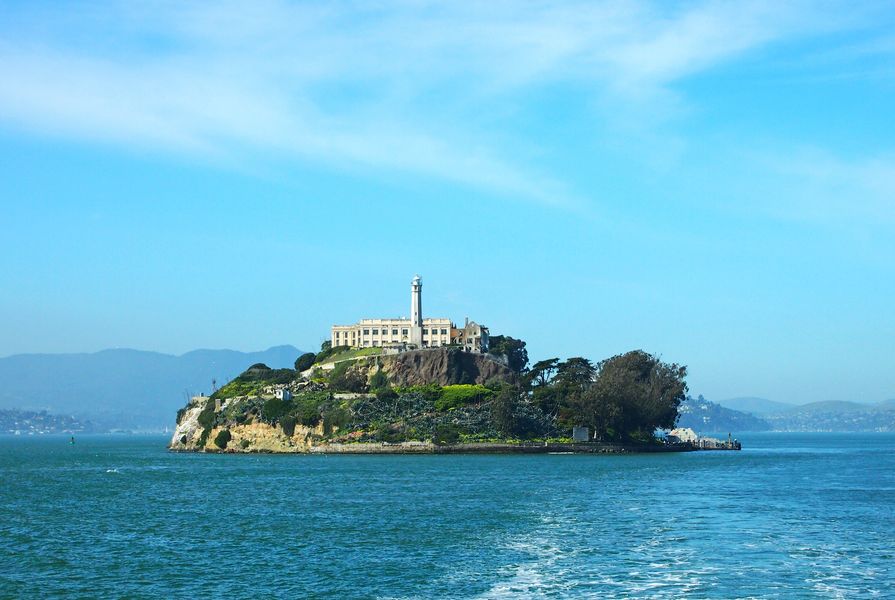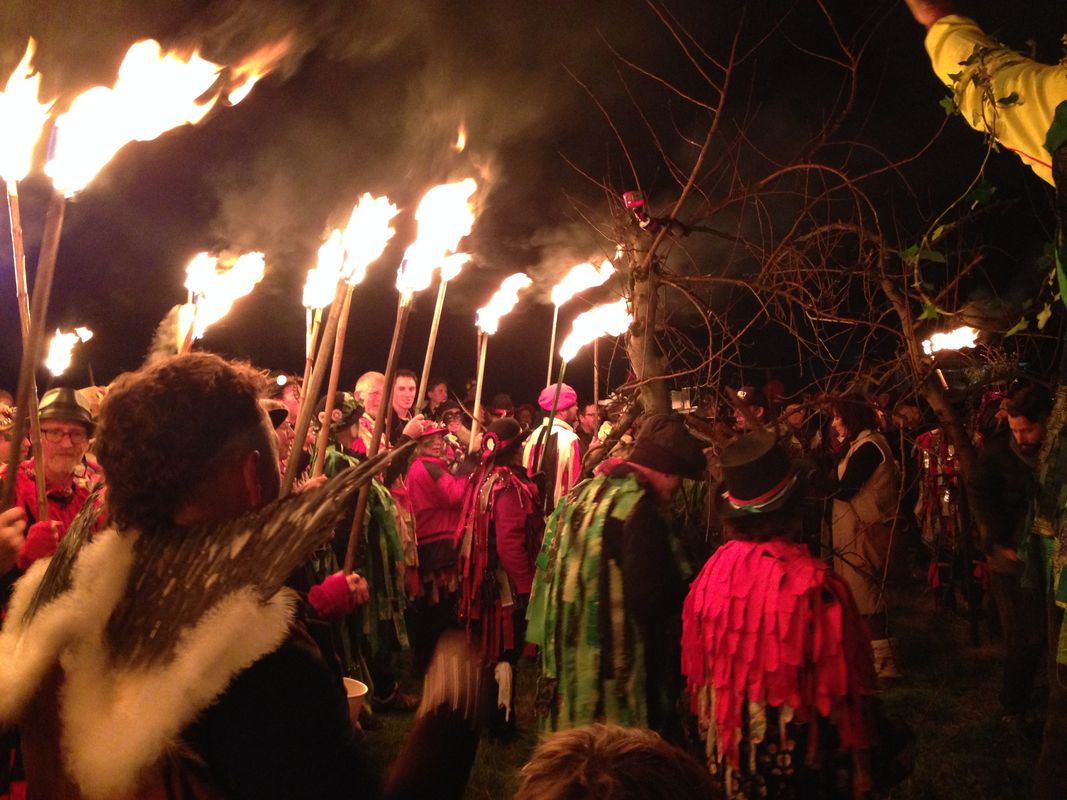The night air is filled with the clanging of wooden spoons on pots, mixed with the hoots of the large crowd. Elevated above the masses, a man standing on a bale of hay speaks into a microphone. He is a shadowy figure, haloed in fiery torchlight – a cross between a morris dancer and a tree. With painted face and fist punched into the air, he instructs the audience to follow him in song:
To blow well and to bear well,
And so merry let us be.
Let every man drink up his cup
And health to the old apple tree.
The Huon Valley Mid-Winter Festival in Tasmania’s south has at its heart the pagan tradition of ‘wassailing’, which involves noisy celebrations to drive out evil spirits and to encourage a healthy harvest of apples – not to mention a fruitful future of cider production. As the crowd sings, cider is tipped at the base of the trees, and it is difficult to determine where nature begins and culture ends. In the shadows, the ‘Wassail King’ is figure of both tree and man. He stands in front of the apple trees as though marshalling his troops, and he is surrounded by a crowd that is slowly transforming into creatures of the night.
This cultural landscape is more than ‘nature’ and ‘culture’, it is greater than the ‘tangible’ and ‘intangible’, and it is a ritual that captures the blurred interrelatedness of land and life. Our descriptions of what the concept ‘cultural landscapes’ can encompass have amplified in richness beyond catchphrases in which they are ‘a bridge between culture and nature’, ‘an interface between nature and culture’, or ‘the combined works of nature and man’. Yet despite our growing confidence in recognising and describing our varied and myriad heritage(s) as cultural landscapes, we generally consider their management from a reserved distance. As such, the mechanisms that have been developed to cater for cultural landscapes within heritage management would not easily accommodate the wassailing I describe above. National park agencies have been leaders in the translation of the ideas of cultural landscapes into practical heritage management. The United States National Park Service and Parks Canada have taken leading roles in incorporating cultural landscapes into their management policies since the early 1980s.
The North American embrace of cultural landscapes has occurred in conjunction with a new phase of conservation biology that recognises the connectivity of humans and ecological processes, and it has influenced cultural landscape management in Australia. Nevertheless, across all three countries, it has been difficult to shake the ingrained belief that the term ‘national park’ is synonymous only with ‘nature’.
Canada’s Green Gables Heritage Place on Prince Edward Island is managed by Parks Canada and is associated with author Lucy Maud Montgomery.
Image: Paulette Wallace
A US national parks approach to cultural landscapes
The US National Park Service recognises cultural landscapes as one of five resource types, the others being archaeological resources, ethnographic resources, historic and prehistoric structures, and museum management. There are four general types of cultural landscapes that are not mutually exclusive: historic sites, historic designed landscapes, historic vernacular landscapes, and ethnographic landscapes.
The four general types of cultural landscapes have ‘landscape characteristics’ which recognise mainly visible, tangible aspects. When grouped together, these give a landscape its ‘historic character’ (Page & others 1999). The landscape characteristics range from large-scale patterns to site details and materials, and they provide an organised structure for reporting on cultural landscapes. Yet while landscape characteristics act as a useful organising tool, they also work to control and compartmentalise heritage values in a manner that cancels out the fluid relationships which are such a central component of cultural landscapes.
In addition, this approach to cultural landscapes by the US National Park Service requires someone trained to decipher the different nuances of the landscape characteristics, which excludes all who are not trained in these methods. Perhaps most pointedly, it omits the involvement of the communities which have connections with the cultural landscapes managed by the US National Park Service.
A program of ‘national heritage areas’, developed alongside the US National Park Service’s approach to cultural landscapes, does recognise the contemporary social values of local communities with connections to these areas. Yet national heritage areas are located on land that is not a part of the national park system, they are governed by their own legislation, and they are led by public/private partnerships. The US National Park Service is involved only in an advisory capacity and as a provider of limited financial assistance (National Park Service US).
But while the US National Park Service has dominated the direction taken by cultural landscape policies for heritage management in the United States, a shift has been occurring which promotes an alternative, more localised, cultural landscapes approach – one which recognises contemporary social values as being an extension of the historical values of the past. This national heritage areas initiative is not incorporated into the US National Park Service’s cultural landscapes program, and does not have the status or level of funding that national parks receive.
Parks Canada’s ‘cultural landscapes’
In a similar vein to the US National Park Service, Parks Canada defines cultural landscapes as a category of historic place, along with archaeological sites, buildings and engineering works. In Parks Canada’s Standards and guidelines for the conservation of historic places in Canada, character-defining elements separate the various components of a landscape. The idea of cultural landscapes is therefore not so much about examining how natural and cultural values come together, as it is about grouping together collections of related historic items. At the same time, Parks Canada has also been engaging with the concept of ‘Aboriginal cultural landscapes’, which focuses on the complex relationship that Aboriginal people have with the land, and which underlines that Aboriginal cultural landscapes ‘are not relicts but living landscapes’. Apart from the cultural landscapes program of Parks Canada, Aboriginal cultural landscapes are being used directly in national park management plans. This has happened, for example, in Torngat National Park, ‘Canada’s 42nd and newest national park, established to protect heritage resources and to provide opportunities for Canadians to connect to the Northern Labrador Mountains natural region — an Inuit homeland’ (Buggey 1999).
According to the park’s management plan, the ‘cultural landscape’ is one in which people of Inuit heritage still maintain strong connections with the park area, and continue to journey to the Torngat Mountains region to hunt and fish. This usage of ‘cultural landscape’ is heavily determined by local circumstances. Most obviously, it acknowledges the present day social values which are connected to the heritage values of the past.
Huon Mid-Winter Festival 2015.
Image: Paulette Wallace
Notions of cultural landscapes in Australia
In Australia, policies have been developed for cultural landscape management in national parks in New South Wales and Victoria which have not been embedded into park management to the same extent as in the US National Park Service and Parks Canada. But what is noteworthy in Australia is the growing local activism advocating for cultural landscape-inspired initiatives that recognise and manage people’s past, present and future heritage values.
One outstanding example is the work of the Winda-Mara Aboriginal Corporation and the Gunditj Mirring Traditional Owners Aboriginal Corporation in southwestern Victoria to acknowledge and care for the Budj Bim National Heritage Landscape, and to lobby for Budj Bim’s inclusion on Australia’s tentative list so that it can be nominated for World Heritage status. Another initiative is the work undertaken by a regional development authority and six local councils in South Australia to recognise the working agricultural cultural landscape of the Mount Lofty Ranges. Then there are the efforts of Ballarat City Council to develop a ‘historic urban landscape approach’ to manage their changing city in a way that actively engages with its local community, and which respects its historic past, while acknowledging the need for growth. These local groups are innovating and pushing the boundaries of how cultural landscapes should be considered and managed in Australia, while underlining the need to adjust public perceptions to recognise that national parks agencies are not necessarily the trailblazers to follow. The Australian initiatives also suggest that the direction for how we continue to develop our thinking and practices for the management of cultural landscapes might be found at the local ‘grass-roots’ level — which has got to be good news for the apple harvest and the future of wassailing in Tasmania’s Huon Valley.
This article was originally published in Australian Garden History, volume 27 no 2, October 2015.
References
Robert Page, Cathy Gilbert and Susan Dolan, A guide to cultural landscape reports: contents, process and techniques, National Park Service US, Department of the Interior, Washington DC, 1998, http://www.nps.gov/cultural_landscapes/Documents/Guide_to_Cultural_Landscapes.pdf.
National Park Service US, Department of the Interior, What Are National Heritage Areas? http://www.nps.gov/heritageareas/FAQ/.
A Federal Provincial and Territorial collaboration, Standards and guidelines for the conservation of historic places in Canada, Parks Canada, Gatineau, Quebec, http://www.historicplaces.ca/en/pages/standards-normes.aspx.
Susan Buggey, An approach to aboriginal cultural landscapes, Parks Canada, 1999, p. 36. http://www.pc.gc.ca/docs/r/pca-acl/index_e.asp.
Parks Canada, Tongait KakKasuangita SilakKijapvinga: Torngat Mountains National Park of Canada management plan, Parks Canada, 2010, p. 1. http://www.pc.gc.ca/eng/pn-np/nl/torngats/plan.aspx.


















